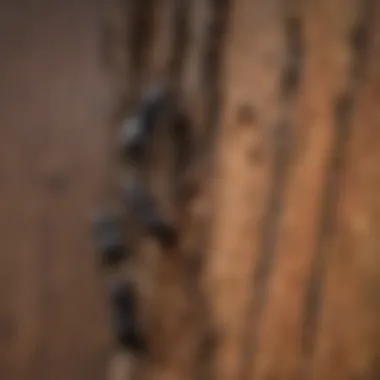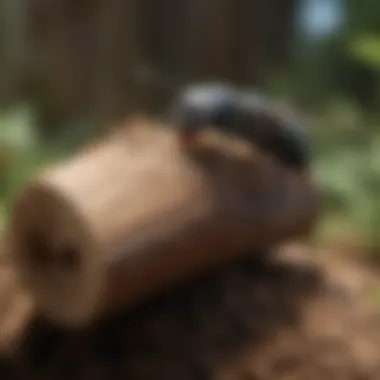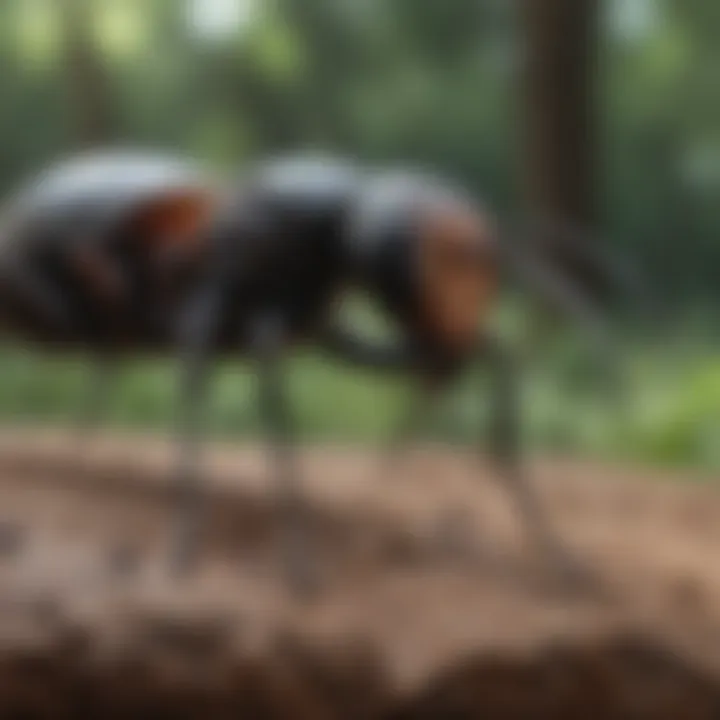Effective Strategies for Eliminating Carpenter Ants


Intro
Carpenter ants are a common yet troublesome pest, particularly when they infest trees. Understanding their biology and behaviors is crucial in combatting these pests effectively. These ants create nests by tunneling through wood, which can cause significant damage to trees, leading to health decline or even death. This article provides a thorough analysis of elimination strategies, highlighting signs of infestations, the impact of these ants on trees, and various treatment options.
Detecting an infestation early can save homeowners from serious problems. Knowing the signs can help in taking action swiftly before the situation becomes severe. The article also presents a range of chemical and natural remedies to tackle these pests and discusses preventive measures for the future. Through a combined approach of informed decision-making and practical strategies, it is possible to manage carpenter ant populations effectively.
Design Inspiration
Understanding Carpenter Ants
Carpenter ants exhibit specific habits and behaviors. They tend to build their nests in moist or rotting wood, favoring areas that may not be apparent without close inspection. By learning about these characteristics, homeowners can better identify areas of concern in their trees.
"Carpenter ants are social insects. Efficiently eliminating them requires understanding their structure and behaviors."
Infestation Signs
Looks for the following indicators:
- Mounds of wood shavings beneath the tree
- Presence of dead trees or stumps nearby
- Foraging trails visible on tree bark
Recognizing these signs early can help in addressing infestations before they escalate.
Practical Tips
Maintenance & Care
Regular tree maintenance can significantly reduce the risk of infestations. Keeping trees healthy makes them less appealing for nesting. Actions may include:
- Pruning dead or dying branches
- Ensuring proper drainage around the tree
- Inspecting for signs of decay
These measures can help keep trees resilient against pests.
Budgeting & Planning
When considering treatments, it is essential to factor in both short-term and long-term costs. Chemical solutions might provide quick results but can carry a price. Natural remedies are gentler on the environment and can be less costly over time. Evaluate the following options:
- Chemical insecticides: Immediate impact but may require repeated applications.
- Diatomaceous earth: Safe for the environment and effective in the long run.
- Essential oils: Natural options that can deter carpenter ants.
Understanding the costs associated with each method allows for better planning.
Treatment Options
The article will explore various treatment options in detail. Homeowners have two primary paths: chemical solutions or natural remedies. It is vital to choose a method that best suits individual circumstances and preferences.
- Chemical Treatments include brands like Ortho Home Defense and Terro Ant Bait. These are effective for quick action but require careful handling.
- Natural Remedies involve substances like vinegar or essential oils that can deter or kill ants without harming the environment. They might take longer to show results but are safer for nearby flora and fauna.
Understanding Carpenter Ants
Understanding carpenter ants is crucial for homeowners and gardeners who wish to protect their trees from infestations. Carpenter ants can cause significant damage to trees as they excavate wood to create their nests. Gaining knowledge about their biology and behavior enables better identification and management of these pests. Furthermore, recognizing the ecological role of carpenter ants offers insights into the balance they maintain in nature.
Biology and Behavior
Carpenter ants belong to the genus Camponotus, which includes various species varying in size and color. They typically range from 1/4 to 1 inch in length and are often black or bicolored with shades of red. Unlike termites, carpenter ants do not eat wood; instead, they chew it to create their nests. This behavior can lead to hollowing out trees and structural damage over time.
Carpenter ants thrive in moist environments. They prefer dead or decaying wood, making trees that are damaged or dying prime targets. These ants are nocturnal and often forage for food at night, which makes observing them during daylight a challenge. Their diet consists of honeydew from aphids, as well as proteins and sugars from various sources, including other insects and food waste from human settlements.
Life Cycle of Carpenter Ants
The life cycle of carpenter ants consists of four stages: egg, larva, pupa, and adult. The queen lays dozens of eggs, which hatch into larvae. These larvae are fed by worker ants until they pupate. The duration of this cycle can vary but typically takes several weeks to months, depending on environmental conditions and availability of food.
Carpenter ant nests often contain a complex structure with multiple chambers and can have thousands of ants in one colony. Understanding this life cycle helps in targeting control measures effectively. For instance, treatments applied during the larval stage can be more effective than those used on adult ants.
Ecological Role
Despite their reputation as pests, carpenter ants play an important role in the ecosystem. They aid in the decomposition process by breaking down dead trees, which enriches the soil. They also serve as a food source for birds and other wildlife.


However, it can be a delicate balance. While they are beneficial in their natural habitat, their presence in residential areas or cultivated landscapes can lead to conflicts with homeowners. For this reason, it is essential to understand their behavior and impacts thoroughly.
A comprehensive understanding of carpenter ants leads to more informed decisions about management and control strategies.
Identifying Infestation
Identifying an infestation is a key step in effectively eliminating carpenter ants from trees. Early detection can prevent extensive damage and mitigate the cost of treatment. Understanding the signs of an infestation will allow homeowners to take timely action. In this section, we focus on specific indicators and the assessment of damage caused by these pests.
Signs of Carpenter Ants
Knowing the signs of an infestation can significantly aid in prompt action. Cartier ants can be elusive, so being able to recognize the specific signs they leave behind is essential for effective treatment.
Visual Indicators
Visual indicators are often the most noticeable signs of carpenter ant presence. Homeowners should look for large, black ants that range between 6 to 12 millimeters in length. These ants are usually seen wandering around trees, particularly in the late spring and summer. A key characteristic of visual indicators is the presence of exit holes in trees, which can appear as small, perfectly round holes.
The advantage of recognizing these visual cues is the ability to identify an infestation early. Spotting these signs early means less damage to the tree, which can save time and resources. However, visual indicators can sometimes be misleading, given that similar signs might be present for other pests.
Sound Cues
Another aspect is sound cues. Carpenter ants can be heard making a faint rustling sound as they tunnel through wood. This noise is most prominent during the evening or at night, when the ants are more active. One benefit of utilizing sound cues is that they provide a non-invasive method for monitoring ant activity. Homeowners can quietly observe and listen without disturbing the tree.
However, sound may not always be perceptible, making it a less reliable indicator compared to visual observations. Additionally, confusion might arise with other species of insects, which could lead to misinterpretation of the sounds detected.
Frass and Debris
Frass is another significant sign of carpenter ant infestations. It consists of small wood shavings and insect excrement that the ants push out of their tunnels. Homeowners often find these droppings beneath infested trees. A key characteristic of frass is its color, which can range from light brown to dark brown, depending on the type of wood.
The unique feature of frass is that it can help homeowners differentiate carpenter ants from other wood-destroying pests. Finding frass provides concrete evidence of activity within the tree. However, since frass can also be mistaken for debris from other insects, it is essential to consider other signs alongside it for an accurate assessment.
Assessing Damage to Trees
Assessing the damage caused by carpenter ants is another critical process. Understanding the extent of damage is vital for deciding on an effective treatment strategy.
Types of Damage
The type of damage caused by carpenter ants typically includes hollowed-out wood in trees. This damage can manifest as shallow galleries that weaken the structure of the tree. A significant characteristic of this type of damage is that it tends to occur within the heartwood. This type of damage can make trees more susceptible to wind and other environmental stressors.
Assessing damage is beneficial since it helps gauge the severity of infestation. Homeowners can prioritize which trees need immediate attention. However, overestimating the damage can lead to unnecessary treatments or tree removals that may not be needed.
Impact on Tree Health
The impact on tree health can be profound if carpenter ant infestations are left unaddressed. Over time, the structural integrity of the tree can be compromised. This leads to various health issues, including stunted growth and increased vulnerability to diseases.
The critical aspect to consider is that the health of the tree is directly linked to its surrounding ecosystem. Healthy trees provide shelter and food to numerous species. Therefore, preserving tree health is a vital component of local biodiversity. On the downside, the repercussions of an infestation may not be immediately visible, making surveillance important for maintaining tree health.
Methods of Elimination
The elimination of carpenter ants from trees is crucial for maintaining tree health and preventing structural damage to wooden elements near infested areas. These pests can undermine the stability of trees, leading to costly repairs and potentially the loss of valuable landscaping. This section delves into various elimination methods, ranging from chemical treatments to natural remedies and trapping strategies. Understanding these methods allows homeowners to choose a strategy that fits their preferences and needs.
Chemical Treatments
Chemical treatments are often considered the first line of defense in dealing with carpenter ants. They offer a quick solution to infestations, effectively targeting the pests and minimizing damage.
Types of Insecticides
The types of insecticides available vary widely. Common options include pyrethroids, which are known for their fast-acting capabilities. They work by disrupting the nervous system of insects, leading to rapid mortality. The advantage of pyrethroids is their effectiveness in short-term applications. However, they may not provide lasting protection, necessitating follow-up treatments.
Another popular choice is fipronil, which is utilized in bait formulations. Fipronil acts more slowly than pyrethroids but offers residual control, as it can be carried back to the colony by foraging ants. This property allows it to target the entire colony, thus being more effective over the long term. While chemical treatments can be potent, it is important to consider potential effects on beneficial insects and the environment.
Application Techniques
Application techniques play a vital role in the effectiveness of insecticides. Spraying is common for immediate infestations, allowing for comprehensive coverage. Precision in application is crucial to avoid run-off and minimize impact on non-target species.
Baiting is another technique, which can be more effective for managing hidden colonies. By strategically placing bait stations, ants can transport the insecticide back to their nest. This method reduces the risk of exposing non-target organisms and enhances efficacy. It is worth noting that improper application techniques may lead to incomplete treatment and recurring infestations.


Safety Precautions
When utilizing chemical treatments, safety precautions must not be overlooked. Wearing protective gear such as gloves and masks is essential to prevent exposure to harmful chemicals. Furthermore, following manufacturer guidelines ensures proper usage and reduces risk to both humans and pets.
Environmental safety is also a key consideration. Solid waste disposal of containers and unused chemicals is necessary to prevent unintended contamination. Overall, adhering to safety precautions can mitigate risks and ensure effective treatment.
Natural Remedies
Natural remedies offer an alternative to chemical treatments, appealing to homeowners looking for eco-friendly options. These methods can be effective, depending on the severity of the infestation.
Essential Oils
Essential oils are gaining popularity for their pest-repelling properties. Oils like peppermint and tea tree have shown efficiency against carpenter ants. The key characteristic of essential oils is their ability to disrupt the ants' natural pheromone trails, making it difficult for them to navigate.
A unique feature of essential oils is their pleasant scent, which contrasts sharply with synthetic insecticides. However, while they can deter ants, their effects may be short-lived, requiring frequent application. Their effectiveness often varies, necessitating experimentation to find the best option.
Boric Acid
Boric acid is another effective natural remedy. It acts as a slow-acting poison, which worker ants carry back to their colony. This method effectively targets the queen and the rest of the colony. A key characteristic of boric acid is its low toxicity to humans and pets, making it safer than many chemical alternatives.
However, it tends to work slowly, so immediate results should not be expected. Patience is vital, and consistent treatment may be necessary for complete eradication.
Vinegar Solutions
Vinegar solutions serve as another potential weapon in the fight against carpenter ants. Vinegar disrupts the scent trails that ants leave, making it harder for them to communicate and navigate. A high concentration of vinegar can effectively deter foraging ants.
While vinegar is non-toxic and readily available, it is important to note that its effects may be strong, but usually temporary. Regular reapplication is necessary for sustained efficacy.
Trapping Strategies
Trapping strategies provide supplementary tools for managing carpenter ant populations. They can capture ants directly, reducing their numbers over time.
DIY Traps
DIY traps can be easily created from everyday materials. For instance, sugar water traps can attract ants and drown them. A key characteristic of DIY traps is their cost-effectiveness and the ability to create them with minimal effort.
The unique aspect of DIY traps is their adaptability; homeowners can modify them as needed. However, while they can help reduce ant numbers, they may not be comprehensive solutions for severe infestations.
Commercial Options
Commercial options provide ready-made solutions for pest control. Products like pre-made bait stations are designed for easy use and typically contain effective insecticides. The advantage of commercial traps is convenience; they require little setup and offer targeted responses to infestations.
A drawback is that they can be more expensive than DIY approaches. Additionally, reliance on commercial products may lead to limited long-term engagement with the infestation problem.
In summary, the methods of elimination discussed here provide a spectrum of choices for managing carpenter ants in trees. By understanding the strengths and limitations of chemical treatments, natural remedies, and trapping strategies, homeowners can create a comprehensive approach to effectively combat these pests.
Preventive Measures
Preventive measures play a crucial role in the management of carpenter ants in trees. These strategies not only help to eliminate existing infestations but also reduce the likelihood of future occurrences. By taking proactive steps, homeowners can protect their trees and minimize potential damage. Understanding how to maintain trees and manage the surrounding environment is essential.
Tree Maintenance Practices
Regular Inspections
Regular inspections of trees are essential in maintaining their health and identifying signs of pest infestations early. These inspections should focus on areas where carpenter ants typically nest and travel, such as near decayed wood or tree cavities. Regular inspections help in spotting nests or ant trails before they result in significant damage.
One key characteristic of regular inspections is the ability to establish a maintenance routine. It is popular among homeowners who prioritize proactive care for their landscape. A routine that involves visual checks, especially during warmer months, can help catch issues before they escalate.
A unique feature of this practice is its accessibility. Homeowners can perform these inspections without the need for specialized tools. However, the downside is that untrained eyes might miss subtle signs of infestation, which can compromise the effectiveness of this approach.
Pruning Methods
Pruning methods are vital for eliminating potential nesting sites for carpenter ants and improving air circulation in tree canopies. By removing dead or weak branches, homeowners can reduce the likelihood of infestations. Pruning also promotes overall tree health, which is important for resisting pest attacks.
One notable characteristic of pruning is its dual advantage of enhancing tree aesthetics while concurrently preventing pest issues. This makes it a beneficial practice for maintaining a healthy landscape.


The unique feature of pruning is its timing; strategic pruning during the dormant season can be especially effective. On the downside, improper pruning techniques can stress trees or create open wounds that attract other pests.
Environmental Changes
Mulching Considerations
Mulching around trees can greatly influence moisture retention and temperature regulation. However, careful attention must be paid to the type and depth of mulch used, as excessive moisture can create an ideal environment for carpenter ants. Organic mulches should be applied in moderation and kept a few inches away from the tree stem.
A key characteristic of mulching is its ability to improve soil structure and fertility, which indirectly promotes healthy trees that can resist pests. This approach is popular due to its multiple benefits, including reducing weeds and conserving moisture.
A unique aspect of mulching is its effectiveness in regulating tree temperature, particularly in extreme weather. Yet, one must consider that if mulching is done poorly, it can lead to high humidity around the base of the tree, potentially attracting pests like carpenter ants.
Moisture Management
Moisture management is critical in preventing carpenter ants from colonizing trees. Ensuring that trees do not have standing water or excessive moisture around their roots can deter these pests. Draining excess water can reduce wood rot, making habitats less inviting for carpenter ants.
One defining characteristic of moisture management is its role in promoting overall plant health. This strategy is favored by gardeners and tree care professionals alike because healthy trees are less susceptible to infestations.
The unique feature of managing moisture effectively lies in the balance of providing enough water without creating a damp environment. However, ineffective moisture control can lead to other issues, such as root disease, which can further weaken trees and make them more attractive to pests.
In summary, preventive measures are not only about pest elimination but about fostering an environment where trees can thrive. By implementing regular inspections, proper pruning, mindful mulching practices, and effective moisture management, homeowners significantly decrease the chance of carpenter ant infestations.
Long-Term Management Strategies
Effective long-term management of carpenter ants in trees involves a multifaceted approach. Homeowners must prioritize monitoring and community involvement. These strategies are essential in preventing infestations and managing current populations. They help maintain the overall health of both the trees and the surrounding environment.
Monitoring Techniques
Regular Monitoring Schedule
Maintaining a regular monitoring schedule is crucial in the management of carpenter ants. This involves periodic checks of trees to identify any signs of infestations early. The key characteristic of this approach is its proactive nature, which enables prompt action. Regular inspections can provide insight into the pest activity and help homeowners adjust their treatment plans accordingly.
The unique feature of a regular monitoring schedule is its systematic approach to pest management. This method ensures that infestations are caught before they escalate, thus reducing the likelihood of severe damage. An advantage of this strategy is the potential cost savings, as early detection often leads to simpler, less expensive treatment options. However, the disadvantage may be the commitment required to implement this practice consistently.
Engagement with Professionals
Engaging with pest control professionals adds another layer of effectiveness to long-term management strategies. Professionals bring expertise and can develop tailored approaches suited to specific situations. This is a beneficial choice for homeowners who may lack the experience or knowledge to manage infestations independently.
The unique feature here is the access to advanced techniques and products that homeowners might not be able to use. Professional services can provide thorough inspections and advice based on a broader understanding of pest behavior. However, one potential drawback is the cost associated with hiring professionals, which may not be feasible for all homeowners.
Community Involvement
Neighborhood Strategies
Community involvement enhances the effectiveness of long-term management of carpenter ants. Neighborhood strategies can include education and sharing information about local pest problems. This approach builds a collective awareness and fosters collaboration among neighbors.
The key characteristic of neighborhood strategies is that they encourage community action. When multiple homeowners participate in monitoring and managing pests, the impact is greater. The unique feature is the shared experiences and resources that can lead to better pest control. One advantage is that issues may be identified more quickly because of collective vigilance. However, a disadvantage might be varying levels of commitment among community members, which could affect the overall effectiveness of the strategy.
Resource Sharing
Resource sharing plays a significant role in effective long-term management. This can involve sharing pest control equipment, professional contacts, or informative resources. By pooling resources, homeowners can benefit from combined expertise and local knowledge.
The key characteristic of resource sharing is the enhanced support network it creates. This collaboration can lead to innovative solutions and cost reductions. A unique feature of this approach is that it builds community resilience against infestations. An advantage includes increased access to information that may not be easily available. However, a disadvantage could be potential miscommunication about shared resources, which may lead to confusion or inconsistency in pest management efforts.
Long-term strategies are not just about eliminating carpenter ants but also preventing future infestations and ensuring tree health.
Culmination
In summary, addressing the issue of carpenter ants in trees is crucial for maintaining both the health of your landscape and the structural integrity of your trees. This article has provided various insights and strategies to effectively eliminate these pests. Understanding the biology and behavior of carpenter ants helps in recognizing their patterns and vulnerabilities. Identifying signs of infestation allows for timely action, which is essential in preventing severe damage.
The methods of elimination discussed—ranging from chemical treatments to natural remedies—offer flexibility depending on personal preferences and environmental considerations. Furthermore, the importance of preventive measures cannot be overstated. Regular tree maintenance and environmental changes can significantly reduce the risk of future infestations.
Ultimately, an integrated approach combining monitoring, community involvement, and informed action will empower homeowners to defend their trees against carpenter ants effectively. Embracing these strategies not only protects your property but also contributes positively to the ecosystem, ensuring trees remain healthy and resilient.
Summary of Key Points
- Carpenter ants can be detrimental to trees, causing significant structural damage.
- Recognizing infestation signs early enhances the chances of successful elimination.
- Various methods exist for removal, including chemical and natural remedies, offering multiple avenues for treatment.
- Preventive care, including regular inspections and proper maintenance, is essential in avoiding future problems.
- Community engagement and shared resources can amplify effectiveness in management strategies.
Call to Action
As a homeowner or lover of nature, take immediate steps to protect your trees from carpenter ants. Regularly assess your trees for any signs of infestation. When identified, act quickly using the recommended treatments from this article. Engaging with your community can also be beneficial, as collective efforts in managing these pests will yield better outcomes.
Visit resources like en.wikipedia.org and britannica.com for more information on carpenter ants and their management.















